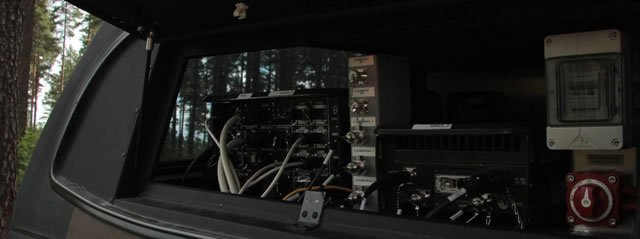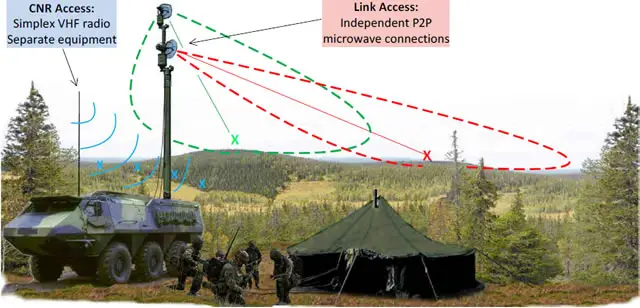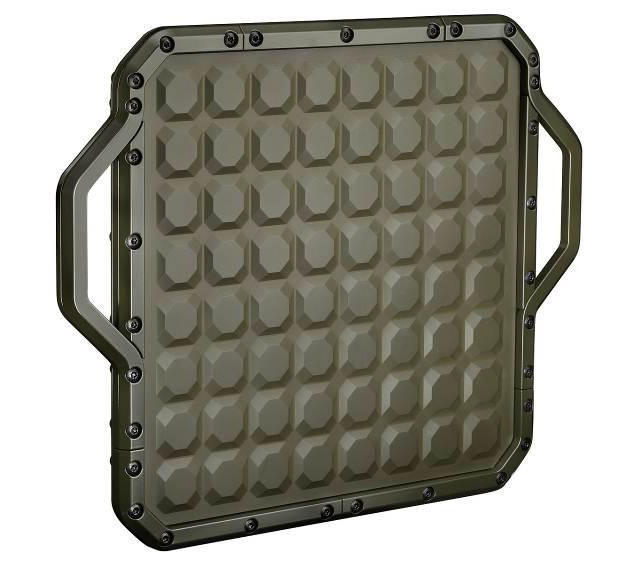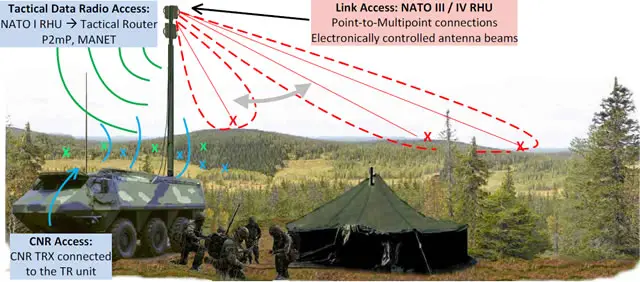Enhancing the Link Network Performance with EB Tactical Wireless IP Network (TAC WIN)
| a | ||||
Defense Industry Technology - Tactical Communication Networks |
||||
| Thursday, March 13, 2014, 10:00 PM | ||||
Enhancing
the Link Network Performance with EB Tactical Wireless IP Network (TAC
WIN) |
||||
Modern
military operations require higher mobility. Will the relay link networks
be able to meet the new requirements? In tactical communications the link networks are the critical layer that connect brigade command posts and various operational units such as artillery and combat battalions together. The Combat Net Radio (CNR) sys-tems provide communica-tions for the front line troops equipped with porta-ble and vehicle installed ra-dio equipment allowing in-formation and command messages to be relayed be-tween the command centers and the operational units. However, seamless connec-tivity between the CNR net-work and the link network cannot be always provided due to incombatibility and limited functionality of equipment available. |
||||
 EB Tactical Wireless IP Network (TAC WIN) installed in an army vehicle. Copyright Finnish Defence Forces |
||||
Conventionally,
the link networks have been built with point-to-point links supported by
fixed connec-tions where applicable. Typi-cal examples of such solu-tions
are the YVI 1 and 2 networks deployed by the Finnish Defence Forces since
the beginning of 1990’s [1],[2]. In the YVI networks the link layer
was based on independent microwave point-to-point links connect-ed to data
terminals. The connection to the mobile units was based on separate CNR
and other equipment either on VHF or HF frequen-cies. Later, IP-routers
have been deployed to provide seamless IP-data transfer over the entire
network. An example of a conventional tactical network architecture is depicted
in Figure 1. Alt-hough the radio link stations are typically vehicle mount-ed,
setting up and configur-ing such links require manual work starting from
putting up the antennas, determin-ing correct antenna directions, configuring
radio fre-quencies and establishing the connections to other networks according
to a pre-determined plan before the actual communications link is operational
and ready to be used. Successful opera-tion is therefore highly de-pendent
on the operators’ skills and motivation and the network configuration
can be considered as fixed with little or no mobility support. |
||||
 Figure 1: Tactical communications system architecture example (Copyright Elektrobit) |
||||
| To
reach the desired reliability level and to avoid interference between
adjacent network nodes, careful planning of the operation including node
positions, frequency mapping and antenna directions is required. After
getting everything setup, the connections should work well as long as
the conditions remain unaltered. However, if the planned frequencies become
interfered, nodes disconnect from the network or if moving the nodes to
new locations is required, the situation becomes quite challenging. The
network must be reconfigured and this means again manual work, which is
time consuming. In the worst case just a tiny human error can block the
connections for hours. From the wireless technology point of view, the link networks have deployed radio solutions similar to transmission links used in wireless backhaul networks that carry voice and data traffic for commercial operators. The transmission links have been based on microwave links and data routers connecting the individual links together. Based on mature technology, the conventional solution represents a straightforward way to provide high throughput and good reliability for fixed link applications. However, the major drawback of such a solution is its very limited ability to adapt itself to any changes and lack of mobility, which is a severe limitation considering the modern military operations. High mobility is a must as the troops move in quickly on land, sea or in the air. Alsothe “front line” changes its location continuously. In addition to new combat tactics, increased firepower and better equipment, this trend sets new requirements also to the communications systems. Although the link network can be considered less mobile than the tactical front-line radio systems operated in the battlefield, the link network must be able to adapt to the highly dynamic environment and to keep up with the moving front line troops. This is a real challenge for conventional link networks and the problem has been identified by military organizations already years ago [3]. |
||||
 Figure 2: The conventional point-to-point link solution (Copyright Elektrobit) |
||||
| EB
Tactical Wireless IP Network (TAC WIN) is a novel solution providing outstanding
performance for the link network communications among other applications.
It replaces the traditional point-to-point link networks with a flexible
high performance broadband network supporting quick automatic configuration
and mobility. With its ability to support multiple network topologies
including point-to-point (P2P), point-to-multipoint (P2mP) and more complex
MANET configurations (Mobile Adhoc Network), EB TAC WIN allows more flexibility
to adapt the network to the situation, which means higher tolerance to
any threat that might block a link connection or disable network nodes.
The ability to establish and maintain connections to multiple nodes simultaneously
using a single Tactical Router simplifies the system configuration and
allows quick changes in traffic routing. In addition to link network connections,
the same Tactical Router supports connection to the Tactical Data Radio
as well as legacy Combat Net Radio systems. For this purpose, Radio Head
Units providing access on NATO I, NATO III and NATO IV frequency bands
are currently provided. As a Software Defined Radio (SDR) solution (),
EB TAC WIN supports running multiple waveforms simultaneously allowing
optimized waveforms to be deployed with the same equipment, for example,
ESSOR or WNW for Tactical Data Radio access and EB TAC WIN high data rate
for the link layer access (Figure 3). In addition to supporting flexible
network topologies and access to multiple network layers with the same
equipment, EB TAC WIN supports IP-data transfer throughout the entire
network. This forms a solid base for various enduser services including
voice, data and multimedia information transfer. |
||||
 Figure 3: The integrated RH-IV Radio Head Unit |
||||
|
In its standard configuration, each Tactical Router is able to establish
three completely individual antenna beams with each beam serving multiple
users within its coverage area. With the optional integrated RH-IV Radio
Head Unit (Figure 4), especially designed for highperformance link applications,
EB TAC WIN is able to combine the performance of a directional high-gain
antenna into the ability to provide service in a wider sector with its
electronically controlled antenna beams. This makes setting up the connections
easier and quicker as the antennas need no longer to be pointed precisely
towards the other end. In addition, with adaptive beam control it will
be possible to serve multiple users in different directions by switching
the beams fully synchronized to the transmission according to where the
other end is located. Although the best link performance will be achieved
with high-gain directional antennas, EB TAC WIN also supports using omnidirectional
antennas if a single sector node covering 360 degrees is required. This
is typically applicable for Tactical Data Radio access operated at lower
frequencies such as 225- 400MHz (NATO I) requiring support to high mobility
and adhoc routing. |
||||
 Figure 4: An example of the connectivity provided by a single EB TAC WIN node equipped with two Radio Head Units and an interface to a legacy CNR system. (Copyright Elektrobit) |
||||
| RH-IV
unit, further development is on-going. A novel antenna concept for NATO
III band deploying rapid beam steering technology capable of covering
the entire 360 sector with each beam is currently under development. The
concept consists of a compact antenna unit supporting connections to 1-
3 Radio Head Units and the control logic required to control the beam
directions and to establish and track connections between nodes. In addition
to the 360 degree coverage, the antenna unit is able to switch its beam
from one direction to another within a fraction of a second allowing the
same beam to provide real-time communications virtually to all directions
like an omnidirectional antenna but with the advantages of the directional
high-gain antenna including enhanced interference suppression. With the
new antenna solution the advantages of EB TAC WIN can be fully deployed
providing significant performance gain over the traditional link solutions.
In addition to the communications performance, the concept allows quick
set-up of the system. The operators will only have to park their vehicle,
put up the antenna mast, switch on the equipment and the network connections
will be established automatically, which is also a great improvement compared
to the traditional link systems. Currently, Elektrobit is leading one of the main activities in the Finnish Defence Force Technology Programme 2013. The aim of this activity is to develop solutions improving the performance of the tactical communication networks. The activity comprises multiple work packages with focus on the wireless network performance. One of the workpackages aims at developing a cost efficient antenna concept such as the one described in this article. Together with cognitive control algorithms, significant gain in the link network performance can expected. In addition to concept development, the goal is to demonstrate the concept with real EB TAC WIN network in the near future. |
||||
| REFERENCES |
||||



























